 |
|
 |
| |
发行人:林恭如所长 编辑委员:李翔杰教授 主编:林筱文 发行日期:2018.11.30 |
| |
|
 |
|
 本所教授指导博士生荣获「财团法人中技社2018年度科技奖学金」,特此恭贺!获奖名单如下:
本所教授指导博士生荣获「财团法人中技社2018年度科技奖学金」,特此恭贺!获奖名单如下:
|
学生姓名
|
奖 项 |
指导教授 |
|
桑德扬 |
财团法人中技社2018年度「科技奖学金」—境外生生活助学金(博士生) |
黄升龙 |
|
张博涵 |
财团法人中技社2018年度「科技奖学金」—研究奖学金(博士生) |
吴志毅 |
本所12月份演讲公告:
|
日期
|
讲者简介 |
讲题 |
地点 |
时间 |
|
光电所专题演讲 |
|
12/7
(Fri) |
潘宗光教授
前香港理工大学校长
|
佛教与科学 |
博理馆
101演讲厅 |
15:30~18:00 |
|
12/21
(Fri) |
陈瑞曾教授
The University of Texas, Austin |
待订 |
电机二馆
105演讲厅
|
15:30~17:00 |
|
|
 |
|
 |
|
| |
|
 |
|
11月份「光电所专题演讲」花絮(花絮整理:姚力琪) |
|
时间: |
2018年11月2日(星期五)下午2时20分 |
|
讲者: |
陈又诚教授(Nanyang Technological University, Singapore) |
|
讲题: |
Bio-Lasers: An Emerging Field Bridging Laser Photonics and Biomedicine |
|
|
本所于11月2日(星期五)邀请陈又诚教授于电机二馆105演讲厅发表演说,讲题为「Bio-Lasers: An Emerging Field Bridging Laser Photonics and Biomedicine」。陈又诚教授于2011学年度毕业于本所硕士班,之后前往美国密西根大学取得生医工程博士学位,现服务于新加坡南洋理工大学,是本所旅外杰出校友。本次演讲本所教师及学生皆热烈参与演讲活动,演说内容丰富精彩,与现场同学互动佳,师生皆获益良多。 |
|
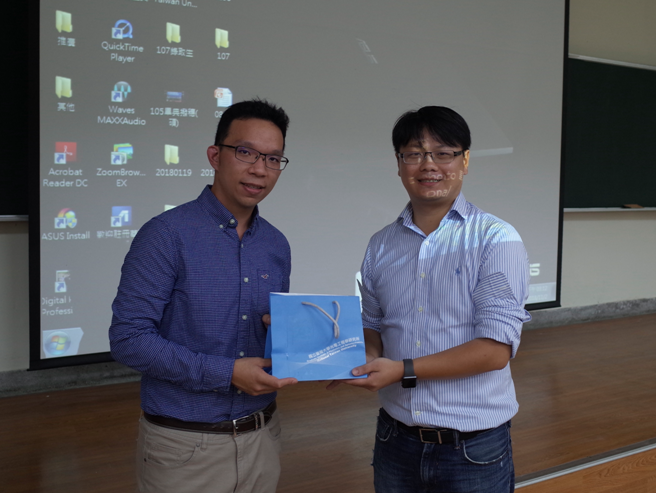 |
|
陈又诚教授(左)与本所李翔杰教授(右)合影 |
|
|
时间: |
2018年11月2日(星期五)下午4时 |
|
讲者: |
郑克勇教授(Electrical Engineering Dept., National Tsing Hua University) |
|
讲题: |
Evolution of AlGaN/GaN Heterojunction Bipolar Transistors |
|
|
郑克勇教授于11月2日(星期五)莅临本所访问,并于博理馆105演讲厅发表演说。郑教授本次演讲题目为「Evolution of AlGaN/GaN Heterojunction
Bipolar Transistors」。本次演说内容丰富精彩,与现场同学互动佳,师生皆获益良多。 |
|
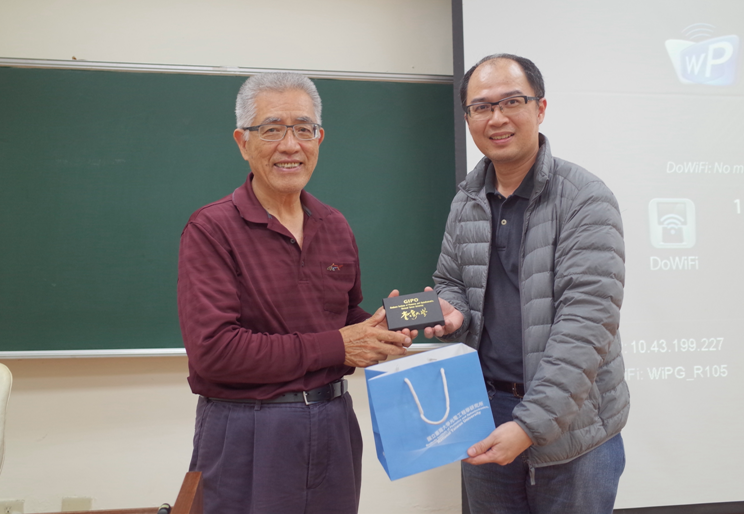 |
|
郑克勇教授(左)与本所副所长黄建璋教授(右)合影 |
|
|
光电所「旅外杰出校友专题」(花絮整理:姚力琪) |
|
时间: |
2018年11月23日(星期五)下午2时20分 |
|
讲者: |
Ph.D. Candidate Yu-Hung Lai (Applied Physics, Caltech) |
|
讲题: |
Brillouin Laser Gyroscopes |
|
|
本所于11月23日(星期五)邀请Ph.D. Candidate Yu-Hung Lai于电机二馆105演讲厅发表演说,讲题为「Brillouin Laser Gyroscopes」。本所教师及学生皆热烈参与演讲活动,演说内容丰富精彩,与现场同学互动佳,师生皆获益良多。 |
|
|
|
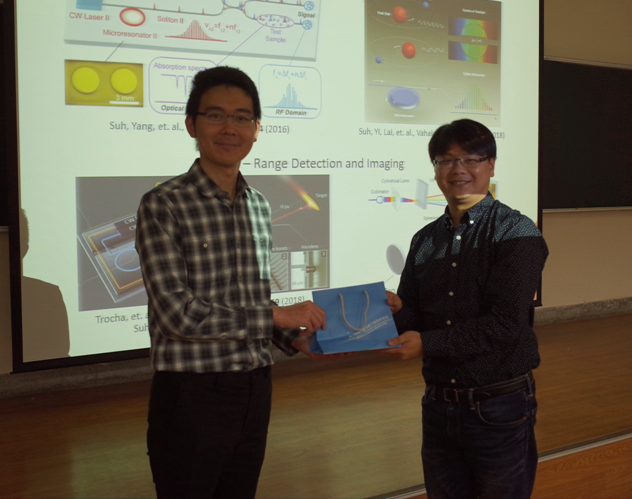 |
|
Ph.D. Candidate
Yu-Hung Lai(左)与本所李翔杰教授(右)合影 |
|
|
|
|
|
 |
|
 |
|
| |
|
 |
Investigating the opacity of corneal and scleral scattering medium via numerical solutions of Maxwell’s equations
Professor Snow H. Tseng
Graduate Institute of Photonics and
Optoelectronics, National Taiwan University
台湾大学光电所 曾雪峰教授
Similar in structure, the cornea and sclera both consist of collagen fibrils, yet, the opacity differs significantly. Here we employ numerical solutions of Maxwell’s equations to model light propagation through cornea-like and sclera-like scattering medium, respectively. By varying the specific structure of the scattering medium, we investigate geometrical factors that can account for the opacity, including wavelength, size and the position of the dielectric cylinders. The reported numerical analysis may shed light to understanding the opacity of scattering medium.
|

|
|
Fig. 1. Schematics of the geometrical structure of cornea and sclera of a human eye. The scleral collagen fibrils are irregular in shape and position, whereas the corneal collagen fibrils are smaller and regular in position.
[http://www.nikon-lenswear.com.tw/zh/eyes-and-vision/how-your-eyes-work]
[http://www.oculist.net/downaton502/prof/ebook/duanes/pages/v4/v4c023.html] |
|
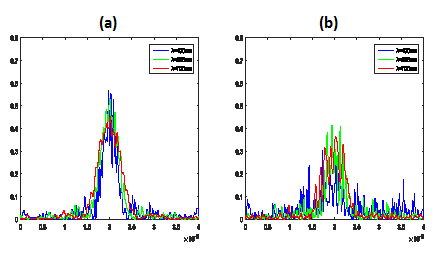 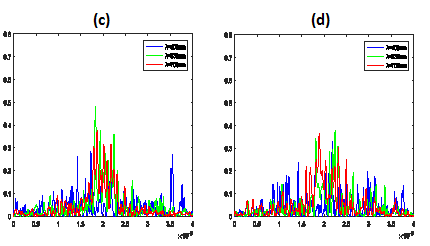
|
|
Fig. 2. Light transmission through scattering medium diminishes with increased constituent dielectric cylinder diameter
d: (a) 120 nm, (b) 200 nm, (c) 280 nm, and (d) 360 nm. The amplitude and direction propagation of light is randomized for each wavelength. |
Broadband Silicon Photonics Polarization Beam Splitters Designed
Using Genetic Algorithm
Professor Ding-Wei Huang
Graduate Institute of Photonics and
Optoelectronics, National Taiwan University
台湾大学光电所 黄定洧教授
In this work, we present a design method for a directional coupler-type polarization beam splitter (PBS) for ultrabroadband operation based on a genetic algorithm (GA). The PBS is discretized into short sections, with the geometric parameters of each section optimized using a GA. For PBSs with an operating wavelength range
λ
= 1400–1650 nm, the insertion losses are less than 0.14 dB and 0.58 dB, and the maximum crosstalk is −20.6 and −16.2 dB for the TE and TM modes, respectively. Under the fabrication error of +/-10nm for the waveguide widths, the device shows negligible performance variation.
|
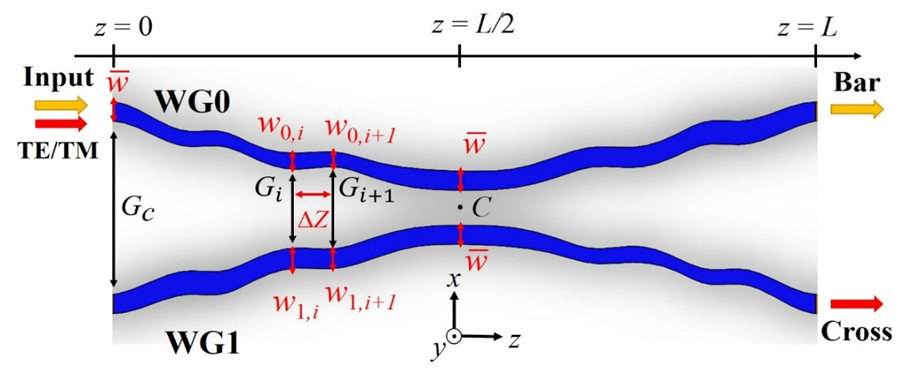
|
|
Fig. 1. Schematic of the Broadband silicon photonics polarization beam splitter. |
|
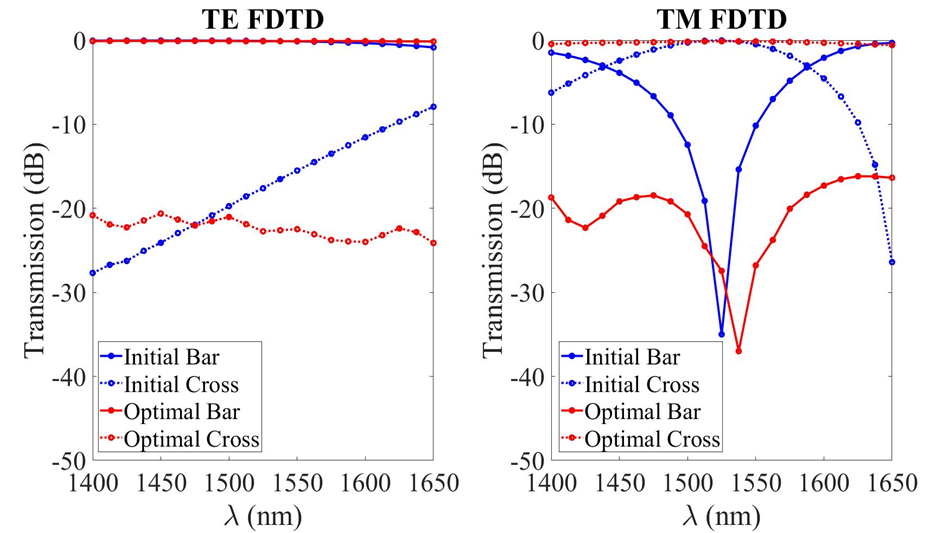
|
|
Fig. 2. Output power at the Bar and Cross ports for the TE and TM modes calculated by 3D-FDTD simulation. |
|
 |
| |
|
|
|
 |
|
| |
|
 |
论文题目:以微机电制程、三维打印成型、精密制造三种技术制作可调变立方角回射器与其数组
姓名:陈昱帆 指导教授:蔡睿哲教授
| 摘要 |
|
在微机电制程技术方面,首先设计三叶草型可调变立方角回射器组件,展示单颗立方角回射器组件的动态调变,并同时验证以驱动镜面破坏正交性作为讯号传输之可行性[1-2]。其次,设计了蜈蚣型可调变立方角回射器组件,展示立方角回射器组件彼此可以相互倚靠、站立,形成一维回射器数组[1-2]。接着,设计具有调变功能之旋转驱动镜面并提出了蝙蝠型可调变立方角回射器二维数组之概念[3]。
在三维打印成型技术方面,以热压法制作可调变立方角回射器数组,制程步骤包括了:以市售反光片Acrylic CCR作为母模,利用铸模蜡翻成Wax CCR,经脱蜡铸造后产生Metal CCR,经研磨、抛光后,以热压法对Printed CCR模型加压加热,最后,将经表面修饰的立方角回射器数组翻模成PDMS CCR。[4]
在精密制造技术方面,设计以线切割加工制作的Folded-up CCR,此Folded-up CCR乃二维平面图案经凹折组装后形成三维立体结构之可调变立方角回射器组件;过程中先以有限元素法对组件进行应力集中与结构力之静态分析,同时也进行模态振形与简谐激振之动态分析,接着利用光追迹软件计算组件之回射效率;最后,将金属钢板加工制作成组件,组装后并量测组件之正交性与回射效率。[5]
[1] Yu-Fan Chen et al, OMN 2011,
2011, 181-182
[2] Yu-Fan Chen
et al, IEEE JSTQE,
2015,
21(4),
123-129
[3] Yu-Fan Chen
et al, OMN 2013,
2013,
105-106
[4] Yu-Fan Chen et al, Optics Communications, doi.org/10.1016/j.optcom.2018.07.011
[5] Yu-Fan Chen
et al, Optical Engineering,
2018,
57(3),
035104
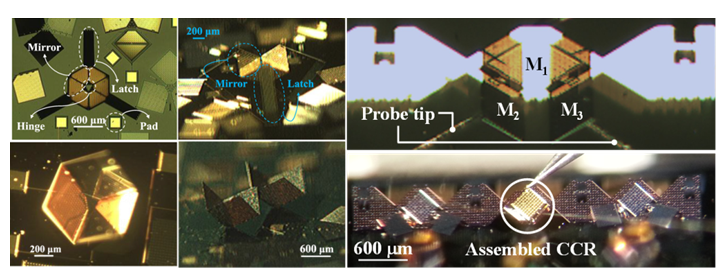 |
|
图一、以微机电制程制作之立方角回射器(三叶草型、蜈蚣型与蝙蝠型)。[1-3] |
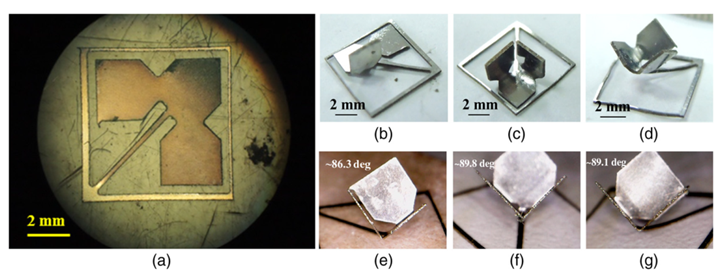 |
|
图二、以精密制造制作之立方角回射器(Folded-up CCR)。[5] |
|
|
|
 |
|
 |
|
|
|
 |
|
 |
|